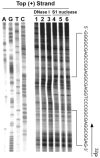Facilitation of a structural transition in the polypurine/polypyrimidine tract within the proximal promoter region of the human VEGF gene by the presence of potassium and G-quadruplex-interactive agents
- PMID: 16239639
- PMCID: PMC1266068
- DOI: 10.1093/nar/gki917
Facilitation of a structural transition in the polypurine/polypyrimidine tract within the proximal promoter region of the human VEGF gene by the presence of potassium and G-quadruplex-interactive agents
Abstract
The proximal promoter region of the human vascular endothelial growth factor (VEGF) gene contains a polypurine/polypyrimidine tract that serves as a multiple binding site for Sp1 and Egr-1 transcription factors. This tract contains a guanine-rich sequence consisting of four runs of three or more contiguous guanines separated by one or more bases, corresponding to a general motif for the formation of an intramolecular G-quadruplex. In this study, we observed the progressive unwinding of the oligomer duplex DNA containing this region into single-stranded forms in the presence of KCl and the G-quadruplex-interactive agents TMPyP4 and telomestatin, suggesting the dynamic nature of this tract under conditions which favor the formation of the G-quadruplex structures. Subsequent footprinting studies with DNase I and S1 nucleases using a supercoiled plasmid DNA containing the human VEGF promoter region also revealed a long protected region, including the guanine-rich sequences, in the presence of KCl and telomestatin. Significantly, a striking hypersensitivity to both nucleases was observed at the 3'-side residue of the predicted G-quadruplex-forming region in the presence of KCl and telomestatin, indicating altered conformation of the human VEGF proximal promoter region surrounding the guanine-rich sequence. In contrast, when specific point mutations were introduced into specific guanine residues within the G-quadruplex-forming region (Sp1 binding sites) to abolish G-quadruplex-forming ability, the reactivity of both nucleases toward the mutated human VEGF proximal promoter region was almost identical, even in the presence of telomestatin with KCl. This comparison of wild-type and mutant sequences strongly suggests that the formation of highly organized secondary structures such as G-quadruplexes within the G-rich region of the human VEGF promoter region is responsible for observed changes in the reactivity of both nucleases within the polypurine/polypyrimidine tract of the human VEGF gene. The formation of the G-quadruplex structures from this G-rich sequence in the human VEGF promoter is further confirmed by the CD experiments. Collectively, our results provide strong evidence that specific G-quadruplex structures can naturally be formed by the G-rich sequence within the polypurine/polypyrimidine tract of the human VEGF promoter region, raising the possibility that the transcriptional control of the VEGF gene can be modulated by G-quadruplex-interactive agents.
Figures









References
-
- Folkman J. Tumor angiogenesis: therapeutic implications. N. Engl. J. Med. 1971;285:1182–1186. - PubMed
-
- Folkman J. Role of angiogenesis in tumor growth and metastasis. Semin. Oncol. 2002;29:15–18. - PubMed
-
- Giordano F.J., Johnson R.S. Angiogenesis: the role of the microenvironment in flipping the switch. Curr. Opin. Genet. Dev. 2001;11:35–40. - PubMed
-
- Goodsell D.S. The molecular perspective: VEGF and angiogenesis. Stem Cells. 2003;21:118–119. - PubMed
-
- Jain R.K. Tumor angiogenesis and accessibility: role of vascular endothelial growth factor. Semin. Oncol. 2002;29:3–9. - PubMed
Publication types
MeSH terms
Substances
Grants and funding
LinkOut - more resources
Full Text Sources
Other Literature Sources

